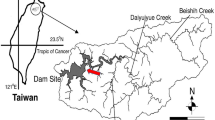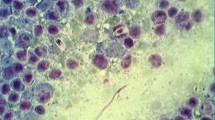Abstract
The Brazilian savannah-like area, the Cerrado region, covers large areas of the country and provides a habitat for a multitude of different animal species. The giant anteater (Myrmecophaga tridactyla) is geographically widespread and one of the typical inhabitants of the Cerrado. They are listed as vulnerable by the International Union for Conservation of Nature and Natural Resources. A population loss of at least 30 % over the past 10 years has been estimated based on local extinctions, habitat loss and deaths caused by fires, roadkills and hunting. Little is known about ecological and in particular parasitic conditions of this highly specialised insectivore species. During September and November 2010 we examined three roadkilled giant anteater for the presence of metazoan ecto- and endoparasites. Besides the cestode species Oochoristica tetragonocephala and the tick species Amblyomma nodosum, we found for the first time the flea Tunga penetrans. Beside morphological flea species identification, we compared a fragment of the 16S rRNA gene of eggs, a molecular method utilised for the first time in this combination. The identification of T. penetrans in M. tridactyla represents a new host record and expands the host and distribution range of the zoonotic flea species.

Similar content being viewed by others
References
Bechara GH, Szabo MPJ, Duarte JMB, Matushima ER, Pereira MC, Rechav Y, Keirans JE, Fielden LJ (2000) Ticks associated with wild animals in the Nhecolândia Pantanal. Ann N Y Acad Sci 916:289–297. doi:10.1603/0022-2585-37.6.979
Bechara GH, Szabo MPJ, Almeida Filho WV, Bechara JN, Pereira RJG, Garcia JE, Pereira MC (2002) Ticks associated with armadillo (Euphractus sexcinctus) and anteater (Myrmecophaga tridactyla) of Emas National Park, State of Goias, Brazil. Ann N Y Acad Sci 969:290–293. doi:10.1111/j.1749-6632.2002.tb04394.x
Briceno AM, Chiachio N, Lugo G, Rodríguez C, García F, Mayoral CT, Valenti MR (2009) Miositis parasitaria asociada a la infestación por Trichinella en Myrmecophaga Trydactila: registro de un caso en Venezuela. Neotrop Helminthol 3:111–114
Coke RL, Carpenter JW, Aboellail T, Armbrust L, Isaza R (2002) Dilated cardiomyopathy and amebic gastritis in a Giant Anteater (Myrmecophaga tridactyla). J Zoo Wildl Med 33:272–279
Costa LP, Leite YLR, Mendes SL, Ditchfield AD (2005) Mammal conservation in Brazil. Conserv Biol 19:672–679. doi:10.1111/j.1523-1739.2005.00666.x
da Fonseca F (1954) Notas de Acarologia XXXVI Aquisicoes novas para a fauna brasileira de Acaros hematophagos (Acari, Macronyssidae). Rev Brasil Ent 1:79–92
Da Silva JMC, Bates JM (2002) Biogeographic patterns and conservation in the South American Cerrado: a tropical Savanna hotspot. Bioscience 52:225–234. doi:10.1641/0006-3568(2002)052[0225:BPACIT]2.0.CO;2
De Avelar DM, Linhares AX, Linardi PM (2012) A new species of Tunga (Siphonaptera: Tungidae) from Brazil with a key to the adult species and neosomes. J Med Entomol 49:23–28. doi:10.1603/ME11111
Diniz LSM, Costa EO, Oliveira PMA (1995) Clinical disorders observed in anteaters (Myrmecophagidae, Edentata) in captivity. Vet Res Commun 19:409–415. doi:10.1007/BF01839320
Gordon RM (1941) The jigger flea. Lancet 2:47–49
Hall (1999) BioEdit: a user-friendly biological sequence alignment editor and analysis program for Windows 95/98/NT. Nucleic Acids Symp 41:95–98
Hesse P (1899) Die Ausbreitung des Sandflohs in Afrika. Geogr Z 5:522–530
Heukelbach J (2005) Tungiasis. Rev Inst Med Trop S Paulo 47:307–313. doi:10.1590/S0036-46652005000600001
Heukelbach J, Wilcke T, Harms G, Feldmeier H (2005) Seasonal variation of tungiasis in an endemic community. Am J Trop Med Hyg 72:145–149
Hinz E (1996) Zur Verbreitung und Ausbreitung der Gattung Tunga (Siphonaptera: Pulicidae) unter besonderer Berücksichtigung von T. penetrans. Mitt Österr Ges Tropenmed Parasitol 18:173–182
Hughes RC (1940) The genus Oochoristica Luhe 1898. Am Midl Nat 23:368–381
Jones EK, Clifford CM, Keirans JE, Kohls GM (1972) The ticks of Venezuela (Acarina: Ixodoidea) with a key to the species of Amblyomma in the Western hemisphere. Brigham Young Univ Sci Bull XVII:1–40
Khalil LF, Jones A, Bray RA (1994) Keys to the Cestode parasites of vertebrates. CAB International, Wallingford
Klimpel S, Mehlhorn H, Heukelbach J, Feldmeier H, Mencke N (2005) Field trial of the efficacy of a combination of imidacloprid and permethrin against Tunga penetrans (sand flea, jigger fela) in dogs in Brazil. Parasitol Res 97:S113–S120. doi:10.1007/s00436-005-1454-z
Klimpel S, Heukelbach J, Pothmann D, Rückert S (2010) Gastrointestinal and ectoparasites from urban stray dogs in Fortaleza (Brazil): high infection risk for humans? Parasitol Res 107:713–719. doi:10.1007/s00436-010-1926-7
Klink CA, Machado RB (2005) Conservation of the Brazilian Cerrado. Conserv Biol 19:707–713. doi:10.1111/j.1523-1739.2005.00702.x
Labruna MB, Sanfilippo LF, Demetrio C, Menezes AC, Pinter A, Guglielmone AA, Silveira LF (2007) Ticks collected on birds in the state of São Paulo, Brazil. Exp Appl Acarol 43:147–160. doi:10.1007/s10493-007-9106-x
Linardi PM, Guimaraes LR (2000) Sifonapteros do Brasil. FAPESP, Sao Paulo
Luchetti A, Mantovani B, Trentini M (2005a) Rapid identification of non-neosomic Tunga penetrans and Tunga trimamillata (Insecta Siphonaptera) specimens through PCR-RFLP method. B Insectol 58:15–18
Luchetti A, Mantovani B, Pampiglione S, Trentini M (2005b) Molecular characterisation of Tunga trimamillata and T. penetrans (Insecta, Siphonaptera, Tungidae): taxonomy and genetic variability. Parasite 12:123–129
Meggitt FJ (1934) On some tapeworms from the bullsnake (Pityopis sayi), with remarks on the species of the genus Oochoristica (Cestoda). J Parasitol 20:181–189
Mehlhorn H, Piekarski G (2002) Grundriß der Parasitologie. Spektrum, Heidelberg
Mittermeier RA, Myers N, Mittermeier CG (2000) Hotspots: earth’s biologically richest and most endangered terrestrial ecoregions. Conservation International, Washington
Möcklinghoff L (2011) Der Große Ameisenbär. Dissertation, Zoologische Forschungsmuseum A. Koenig, University Bonn
Mutlow AG, Dryden MW, Payne PA (2006) Flea (Pulex simulans) infestation in captive Giant Anteaters (Myrmecophaga tridactyla). J Zoo Wildl Med 37:427–429
Nagy N, Abari E, D’Haese J, Calheiros CM, Heukelbach J, Mencke N, Feldmeier H, Mehlhorn H (2007) Investigations on the life cycle and morphology of Tunga penetrans in Brazil. Parasitol Res 101:233–242. doi:10.1007/s00436-007-0683-8
Nofs S, Abd-Eldaim M, Thomas KV, Toplon D, Rouse D, Kennedy M (2009) Influenza virus A (H1N1) in Giant Anteaters (Myrmecophaga tridactyla). Emerg Infect Dis 15:1081–1083. doi:10.3201/eid1507.081574
Oliver JH (1989) Biology and systematics of ticks (Acari: Ixodida). Annu Rev Ecol Syst 20:397–430
Pampiglione S, Trentini M, Fioravanti ML, Onore G, Rivasi F (2002) A new species of Tunga (Insecta, Siphonaptera) from Ecuador. Parassitologia 44:127
Pampiglione S, Fioravanti ML, Gustinelli A, Onore G, Rivasi F, Trentini M (2005) Anatomy of Tunga trimamillata Pampiglione et al., 2002 (Insecta, Siphonaptera, Tungidae) and developmental phases of the gravid female. Parasite 12:241–250
Pampiglione S, Fioravanti ML, Gustinelli A, Onore G, Mantovani B, Luchetti AR, Trentini M (2009) Sand flea (Tunga spp.) infections in humans and domestic animals: state of the arts. Med Vet Entomol 23:172–186. doi:10.1111/j.1365-2915.2009.00807.x
Pereira M, Szabo MPJ, Bechara GH, Matushima ER, Duarte JMB, Rechav Y, Fielden L, Keirans JE (2000) Ticks (Acari: Ixodidae) associated with wild animals in the Pantanal region of Brazil. J Med Entomol 37:979–983. doi:10.1603/0022-2585-37.6.979
Pinto C, Dreyfus A (1927) Tunga travassosi n. sp. parasita de Tatusia novemcinctus do Brasil. Bol Biol 9:174–178
Redford KH (1985) Feeding and food preference in captive and wild Giant anteaters (Myrmecophaga tridactyla). J Zool 205:559–572. doi:10.1111/j.1469-7998.1985.tb03544.x
Resh VH, Carde RT (2009) Encyclopedia of insects. Academic, Burlington
Sambrook J, Russell DW (2001) Molecular cloning: a laboratory manual, 3rd edn. Cold Spring Harbor Laboratory Press, Cold Spring Harbor
Shaw JH, Machado-Neto J, Carter TS (1987) Behavior of free-living anteaters (Myrmecophaga tridactyla). Biotropica 19:255–259
Szabo MPJ, Olegario MMM, Santos ALQ (2007) Tick fauna from two locations in the Brazilian savannah. Exp Appl Acarol 43(1):73–84. doi:10.1007/s10493-007-9096-8
Tamura K, Dudley J, Nei M, Kumar S (2007) MEGA4: molecular evolutionary genetics analysis (MEGA) software version 4.0. Mol Biol Evol 24:1596–1599. doi:10.1093/molbev/msm092
Wagner J (1932) Tunga bondari, eine neue Art der Sandflöhe. Novit Zool 38:248–249
Widmer C, Azevedo CC (2011) Tungiasis in a free-ranging jaguar (Panthera onca) population in Brazil. Parasitol Res 110:1311–1314. doi:10.1007/s00436-011-2625-8
Acknowledgments
We thank Liana Ariza from Universidade Federal do Ceará (Brazil) for the logistic support. Furthermore we like to thank Lina Kurzrock, Biodiversity and Climate Research Centre, Frankfurt, to realize molecular species identification. Jörg Heukelbach is research fellow from the Conselho Nacional de Desenvolvimento Científico e Tecnológico (CNPq/Brazil). This study was supported by a “Projeto Universal” grant from CNPq. The present study was financially supported by the research funding programme “LOEWE—Landes-Offensive zur Entwicklung Wissenschaftlich-ökonomischer Exzellenz” of Hesse’s Ministry of Higher Education, Research, and the Arts.
Declaration
We declare that the conducted study complies with the Brazilian laws.
Author information
Authors and Affiliations
Corresponding author
Rights and permissions
About this article
Cite this article
Frank, R., Melaun, C., Martins, M.M. et al. Tunga penetrans and further parasites in the giant anteater (Myrmecophaga tridactyla) from Minas Gerais, Brazil. Parasitol Res 111, 1907–1912 (2012). https://doi.org/10.1007/s00436-012-3036-1
Received:
Accepted:
Published:
Issue Date:
DOI: https://doi.org/10.1007/s00436-012-3036-1




